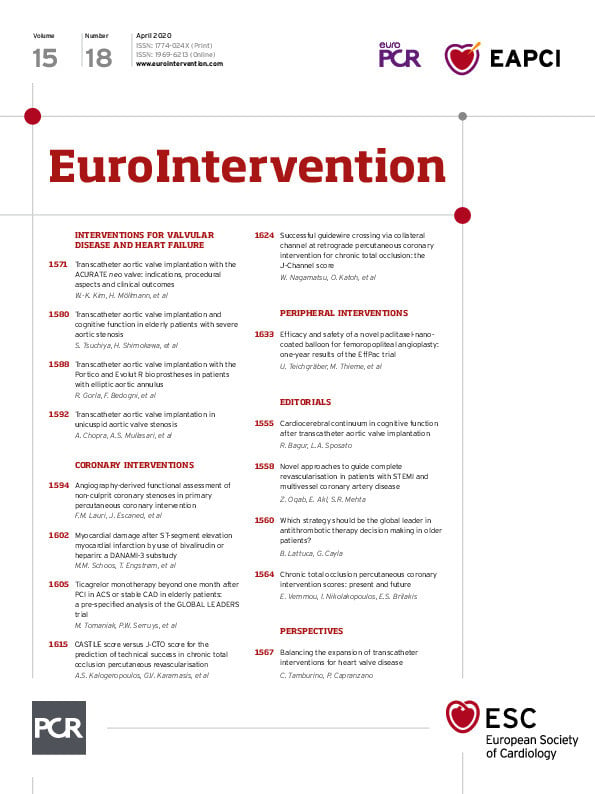It is a strange spring that is deprived of international interventional congresses. The COVID-19 pandemic is severely challenging multiple health systems around the world, and the effort of large and small countries to contain the infection is both admirable and generous. Unfortunately – and understandably – circumstances have led to a review of plans regarding many traditional events in the field of cardiology, such as CIT, TCTAP and ACC. A few years ago I wrote about the importance of foreseeing novel educational platforms when challenging scenarios are on the horizon1. Certainly, at that time, I could not have anticipated the day when an invisible enemy such as the coronavirus would change the plans of many cardiological organisations, and – more importantly – threaten the health of so many people worldwide, forcing entire populations to resort to an instrument of protection as old as quarantine. Waiting for the end of this emergency status, let’s dedicate ourselves to the only contagion we like – that of science and education. These are the hot topics in the electronic April issue of EuroIntervention.
The section on interventions for valvular disease and heart failure once again focuses on TAVI and its many procedural aspects. Firstly, the valve itself. Last year, the results of the SCOPE 1 trial were presented at TCT and simultaneously published in The Lancet2. TAVR with the self-expanding ACURATE neo did not meet non-inferiority compared to the balloon-expandable SAPIEN 3 device with respect to a composite of various early safety and clinical efficacy outcomes. Later this year, SCOPE 2 will assess the ACURATE neo bioprosthesis vis-à-vis another self-expanding bioprosthesis, with a hard primary clinical endpoint at 12 months. Meanwhile, we host a review article from Won-Keun Kim, Helge Möllmann and colleagues on clinical data and best practice for implantation of the ACURATE neo transcatheter valve. In another study from Riccardo Gorla, Francesco Bedogni and colleagues, the Portico and Evolut R valves were compared on the basis of paravalvular leak and device success in 107 TAVI patients with an elliptic aortic annulus. The results of this study may be of interest when deciding on the selection of a self-expanding bioprosthesis. In fact, it is well known that an elliptic geometry may lead to gaps between the aortic root and the prosthesis, which is designed to expand circularly, resulting in paravalvular leak. Another article from Satoshi Tsuchiya, Hiroaki Shimokawa and colleagues highlights the putative impact of TAVI on cerebral blood flow, cardiac output, and cognitive functions in elderly patients. Using paired data at baseline and three months, the results provide the first evidence that TAVI may improve cognitive functions associated with increased cerebral perfusion, especially in the hippocampus. The study is accompanied by an enlightening editorial by Rodrigo Bagur.
Let’s now review as usual the series of articles on coronary interventions. Following the results of the COMPLETE trial, it is now well accepted that patients with STEMI and multivessel disease should be offered complete revascularisation if they do not present with cardiogenic shock. Open questions, however, concern the timing of complete revascularisation and how non-culprit lesions should be identified (e.g., angiographically or physiologically, invasively or non-invasively). Francesco Maria Lauri, Javier Escaned and colleagues have elaborated on this topic by evaluating the diagnostic accuracy of quantitative flow ratio (QFR) for the functional assessment of non-culprit lesions during the acute phase of STEMI. The study is accompanied by an editorial from the principal investigator of the COMPLETE trial, Samir R. Mehta. Another STEMI study, from Mikkel M. Schoos, Thomas Engstrøm and colleagues, reports the comparative efficacy of bivalirudin or heparin in the subset of patients undergoing cardiac magnetic resonance in the DANAMI-3 trial (another trial of complete revascularisation in patients with multivessel disease and acute myocardial infarction). Also in this issue of EuroIntervention, the GLOBAL LEADERS investigators report on the impact of ticagrelor monotherapy in elderly patients undergoing PCI. Although the trial was formally neutral, the analysis was pre-specified and points towards the identification of meaningful subsets for the antiplatelet monotherapy strategy, to be further explored in future investigations conducted in PCI patients with stable coronary artery disease and/or acute coronary syndromes. In that respect, the results of this sub-analysis of GLOBAL LEADERS in the elderly are intriguing and hypothesis-generating. The study features an accompanying editorial from Guillaume Cayla. Let’s now move the spotlight to PCI for chronic total occlusions, with two studies that will attract the interest of both expert operators and beginners. The first study, from Wataru Nagamatsu, Osamu Katoh and colleagues, introduces a novel score model for predicting the success of collateral channel guidewire crossing during retrograde PCI. The score, developed by multivariate analysis with angiographic findings, promises to be quite useful to inform the appropriate selection of collateral channels. Also about prediction rules for PCI of chronic total occlusions, we publish another study from Andreas S. Kalogeropoulos, Grigoris V. Karamasis and colleagues, comparing the novel EuroCTO (CASTLE) score with the J-CTO score for predicting technical success. Interestingly, one score (I’ll let you discover which one) outperformed the other with respect to its discriminatory capacity for (more) complex cases. The study is complemented by the accompanying editorial of Emmanouil Brilakis and colleagues.
Can we leave our peripheral interventions enthusiasts without a new paper in this issue? Certainly not. In the randomised EffPac trial, reported by Ulf Teichgräber, Markus Thieme and colleagues, the safety and efficacy of the Luminor paclitaxel-nano-coated balloon were compared to those of an uncoated balloon catheter in inhibiting restenosis and ensuring long-term patency after 12 months.
This is what we have prepared for you in this electronic April issue. While we continue to foster strategies and new solutions to enhance your experience of the Journal, please do not hesitate to let us know your opinion and your suggestions, and reactions to what you read here, on the website or through social media.
Supplementary data
To read the full content of this article, please download the PDF.

